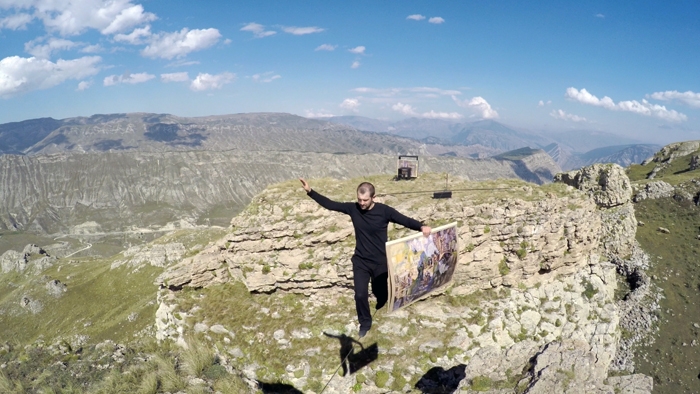Staged in the small but significant Romanian city of Timișoara, historic capital of the long-contested Banat region, the third edition of Art Encounters is framed as a yearlong project rather than a traditional biennial. Emphasising local engagement at the expense of international press, a range of workshops, lectures and screenings were held in the weeks and months before the exhibition even opened. Further thwarting any reduction to neat, easily communicable messages, it is not a thematic exhibition; instead, curators Maria Lind and Anca Rujoiu reference the work of locally born author Herta Müller, comparing the biennial to a confluence of distinct but still inseparable ‘winds’.
Its largest iteration to date, the biennial features the work of 80 international artists, including around 20 – among them Agnieszka Polska, Ahmet Ögüt, Michael Beutler and Céline Condorelli – commissioned to make new work. Unfurling across the city, artworks are installed in railway alleyways and university concourses, on streets, billboards and shopfronts, along with other venues – such as the Corneliu Miklosi Public Transport Museum, the Banat National Museum and the Communist Consumer Museum – more accustomed to the display of objects, if not exactly of contemporary art. This demonstrates the curators’ explicit desire to use preexisting sites as a way of resisting the city’s gentrification. Still, it remains hard not to think that, like most biennials, it represents part of a strategy to do exactly this.
Nonetheless, this curatorial approach gives the exhibition an oddly atmospheric quality, as though the city has been very subtly infiltrated. Its image printed on marketing materials, as an artwork and in shopfronts, Polska’s Wayward Pigeon (2019) – representing an ideal if nonexistent carrier pigeon – seems to recur constantly, like an omnipresent whack-a-mole. In the upper level of the Banat National Museum (housed in the Maria Therezia Bastion, the reconditioned medieval battlements used to ward off repeated Ottoman attacks), Condorelli’s installation Collection Show (2019) is similarly covert, rooted in the selection of preexisting things. Brightly coloured octagonal display stands collecting items sourced from locally held collections of art, communist paraphernalia and regional textiles, the installation is considered and affecting, while simultaneously implying the placeless and infinitely transferable character of much biennial art.
A considerable amount of strong, mainly filmic work is housed outside the old city centre at the Youth House, the striking postwar behemoth that was once the headquarters of the Timiș Communist Youth Union and is now home to, among other things, a coworking space. Fictional but filmed in a documentary style, Ane Hjort Guttu’s Time Passes (2015) presents an uncanny depiction of youth’s unwieldy idealism and indignation, demonstrating the problem of empathy as a rationale for making art. Down in the building’s labyrinthine basement, Every Good Body Dances (2019), a new commission by the young Singaporean artist Kray Chen, consists of a single take showing local folk musicians performing the same song in a range of tempos, from frenetic to funereal: a poignant, abridged take on one of many disappearing worlds. Observing a man carefully transporting Dagestani heritage over an elevated tightrope two paintings at a time, Taus Makhacheva’s cinematic Tightrope, Dagestan (2015) shows something of the tenacity required to prevent losing them entirely.
Polska’s mercurial pigeon appears once again, this time digitally printed on a semi-translucent sheath floating above the central concourse of the Public Transport Museum. Surrounding this cavernous central space – also inhabited by strong sculptural works by Beutler and Bella Rune – are a number of adjacent rooms again mostly showing films. Examining the genesis and eventual failure of the Non-Aligned Movement, Naeem Mohaiemen’s film-length Two Meetings and a Funeral (2017) undermines the naturalisation process underscoring the contemporary status quo. Originally commissioned for Documenta 14 (2017), the film feels resonant in Timișoara: in December 1989, the city was the first part of Romania to declare itself free of Nicolae Ceaușescu’s particularly brutal variant of socialism. At that moment, the apparent inevitability of authoritarianism revealed its contingency. Romania could be something else entirely, or it could be the same as everywhere else.
This decision appears ongoing. Timișoara is clearly changing, with Art Encounters and its 2021 European City of Culture status in particular serving to accelerate this process. In the wake of the country’s 2007 entry into the EU, multinationals are favouring the city as a production and processing centre, while also touting it as a tech hub, thanks in no small part to comparatively cheap labour and a remarkably strong broadband connection. This emergent connectivity also implies the country’s role in affairs it previously could neither see nor name – things that simply arrive, seemingly on the wind. In a tunnel at the city’s northern train station, the Romanian artist Dan Acostioaiei’s mosaic Seas under Deserts (2019) reworks a postcard sent by the artist’s father from Syria during the 1970s, when posted in the country as a cartographer. Showing two smiling women in casually traditional attire, the mural communicates a sense of peaceful antiquity. ‘Souvenir de Syrie’, reads the bold red inscription across its top. Installed in a site emblematic of the city’s strengthening link to the wider world, however, the mural also highlights the inconvenient underside of connectivity. Precisely when freedoms of movement are increasing in Romania, they are reducing elsewhere. Bodies, like winds, hit impasses, or are only permitted to move in one way.
Art Encounters Biennial 2019, Timișoara, 20 September – 27 October
From the December 2019 issue of ArtReview
